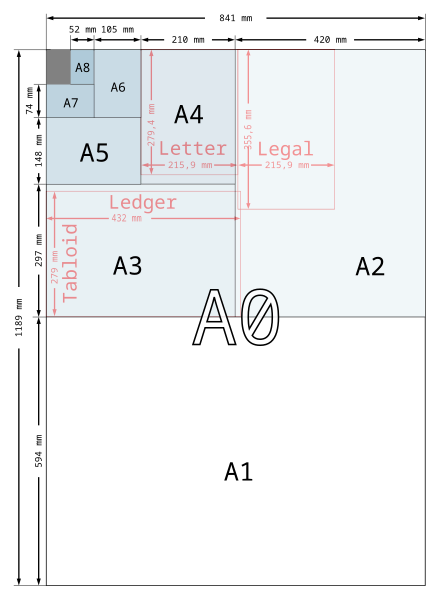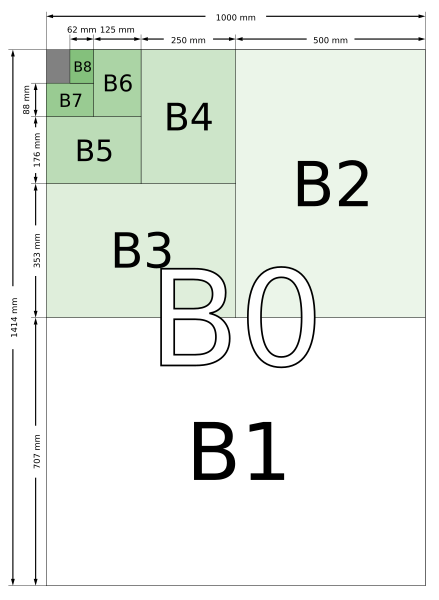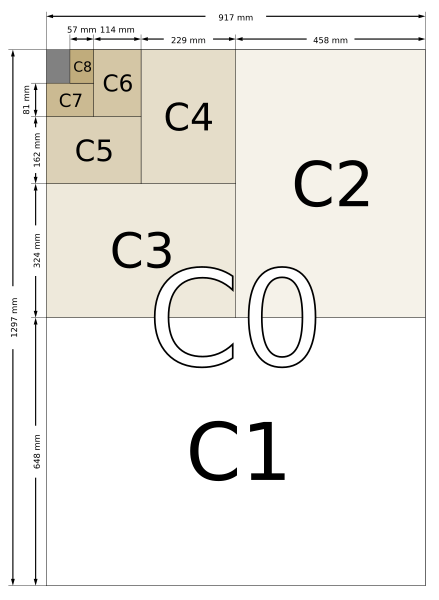ISO and special paper sizes
http://en.wikipedia.org/wiki/Paper_size
http://en.wikipedia.org/wiki/Newspaper_format
http://en.wikipedia.org/wiki/Book_size
http://en.wikipedia.org/wiki/Envelope
Many paper size standards conventions have existed at different times and in different countries. Today there is one widespread international ISO standard (including A4, B3, C4, etc.) and a local standard used in North America (including letter, legal, ledger, etc.). The paper sizes affect writing paper, stationery, cards, and some printed documents. The standards also have related sizes for envelopes.
 |
| A size chart illustrating the ISO A series and a comparison with American letter and legal formats. |
The international standard: ISO 216
A series
The international paper size standard, ISO 216, is based on the German DIN 476 standard for paper sizes. ISO paper sizes are all based on a single aspect ratio of square root of 2, or approximately 1:1.4142. The base A0 size of paper is defined to have an area of 1 m2. With this definition and the given aspect ratio of square root of two, one can calculate the sides of an A0 sheet as follows: The long side is 1 metre multiplied by the square root of the square root (that is, the fourth root) of 2 and the short side is 1 metre divided by the same. Rounded to millimetres, the A0 paper size is 841 by 1,189 millimetres (33.1 in × 46.8 in).
Successive paper sizes in the series A1, A2, A3, and so forth, are defined by halving the preceding paper size along the larger dimension. The most frequently used paper size is A4 210 by 297 millimetres (8.3 in × 11.7 in).
The significant advantage of this system is its scaling: if a sheet with an aspect ratio of
 is divided into two equal halves parallel to its shortest sides, then the halves will again have an aspect ratio of
is divided into two equal halves parallel to its shortest sides, then the halves will again have an aspect ratio of  . Folded brochures of any size can be made by using sheets of the next larger size, e.g. A4 sheets are folded to make A5 brochures. The system allows scaling without compromising the aspect ratio from one size to another—as provided by office photocopiers, e.g. enlarging A4 to A3 or reducing A3 to A4. Similarly, two sheets of A4 can be scaled down and fit exactly 1 sheet without any cutoff or margins. Weights are easy to calculate as well: a standard A4 sheet made from 80 gram/m2 paper weighs 5 grams (as it is one 16th of an A0 page, measuring 1 m2), allowing one to easily compute the weight—and associated postage rate—by counting the number of sheets used.
. Folded brochures of any size can be made by using sheets of the next larger size, e.g. A4 sheets are folded to make A5 brochures. The system allows scaling without compromising the aspect ratio from one size to another—as provided by office photocopiers, e.g. enlarging A4 to A3 or reducing A3 to A4. Similarly, two sheets of A4 can be scaled down and fit exactly 1 sheet without any cutoff or margins. Weights are easy to calculate as well: a standard A4 sheet made from 80 gram/m2 paper weighs 5 grams (as it is one 16th of an A0 page, measuring 1 m2), allowing one to easily compute the weight—and associated postage rate—by counting the number of sheets used.The advantages of basing a paper size upon an aspect ratio of
 were already noted in 1786 by the German scientist and philosopher Georg Christoph Lichtenberg. Early in the 20th century, Dr Walter Porstmann turned Lichtenberg's idea into a proper system of different paper sizes. Porstmann's system was introduced as a DIN standard (DIN 476) in Germany in 1922, replacing a vast variety of other paper formats. Even today the paper sizes are called "DIN A4" (pronounced: "deen-ah-fear") in everyday use in Germany and Austria. The term Lichtenberg ratio has recently been proposed for this paper aspect ratio.
were already noted in 1786 by the German scientist and philosopher Georg Christoph Lichtenberg. Early in the 20th century, Dr Walter Porstmann turned Lichtenberg's idea into a proper system of different paper sizes. Porstmann's system was introduced as a DIN standard (DIN 476) in Germany in 1922, replacing a vast variety of other paper formats. Even today the paper sizes are called "DIN A4" (pronounced: "deen-ah-fear") in everyday use in Germany and Austria. The term Lichtenberg ratio has recently been proposed for this paper aspect ratio.The main disadvantage of the system is type does not scale the same way; therefore, when a page is resized, the type set on it loses legibility as the proportion between the type's x-height, page margins, and leading are distorted. When trim is involved, as in the manufacture of books, ISO 216 sizes are generally too tall and narrow for book production. The distortion is even more pronounced with printed sheet music. European book publishers typically use metricated traditional page sizes for book production.
By 1975 so many countries were using the German system that it was established as an ISO standard, as well as the official United Nations document format. By 1977 A4 was the standard letter format in 88 of 148 countries. Today the standard has been adopted by all countries in the world except the United Statesand Canada. In Mexico, Costa Rica, Colombia, Venezuela, Chile and the Philippines the US letter format is still in common use, despite their official adoption of the ISO standard.
 m2). As a result, B0 is 1 metre wide, and other sizes in the B series are a half, a quarter or further fractions of a metre wide. While less common in office use, it is used for a variety of special situations. Many posters use B-series paper or a close approximation, such as 50 cm × 70 cm; B5 is a relatively common choice for books. The B series is also used for envelopes and passports. The B-series is widely used in the printing industry to describe both paper sizes and printing press sizes, including digital presses. B3 paper is used to print two US letter or A4 pages side by side usingimposition; four pages would be printed on B2, eight on B1, etc.
m2). As a result, B0 is 1 metre wide, and other sizes in the B series are a half, a quarter or further fractions of a metre wide. While less common in office use, it is used for a variety of special situations. Many posters use B-series paper or a close approximation, such as 50 cm × 70 cm; B5 is a relatively common choice for books. The B series is also used for envelopes and passports. The B-series is widely used in the printing industry to describe both paper sizes and printing press sizes, including digital presses. B3 paper is used to print two US letter or A4 pages side by side usingimposition; four pages would be printed on B2, eight on B1, etc. |
| A size chart illustrating the ISO B series. |
 |
| A size chart illustrating the ISO C series. |
Newspaper formats vary substantially, with different formats more common in different countries. The size of a newspaper format refers to the size of the paper page; the printed area within that can vary substantially depending on the newspaper.
In some countries, particular formats have associations with particular types of newspaper; for example, in the United Kingdom, there is a distinction between "tabloid" and "broadsheet" as references to newspaper content quality, which originates with the more popular newspapers using the tabloid format; hence "tabloid journalism".
In the hand press period (up to about 1820) books were manufactured by printing text on both sides of a full sheet of paper and then folding the paper one or more times into a group of leaves or "gathering". The binder would sew the gatherings (sometimes also called "signatures") through their inner hinges and attached to cords in the spine to form the book block. Before the covers were bound to the book, the block of text pages was sometimes trimmed along the three unbound edges to open the folds of the paper and to produce smooth edges for the book. When the leaves were not trimmed, the reader would have to cut open the leaf edges using a knife.
Books made by printing two pages of text on each side of a sheet of paper, which is then folded once to form two leaves or four pages, are referred to as folios (from Latin, foliō, ablative of folium, leaf). Those made by printing four text pages on each side of a sheet of paper and folding the paper twice to form a gathering containing four leaves or eight pages are called "quartos" (meaning "fourths"). Similarly, books made by printing eight pages of text on each side of a sheet, which was then folded three times to form gatherings of 8 leaves or 16 pages each, are called octavos. The size of the resulting pages in these cases depends, of course, on the size of the full sheet used to print them and how much the leaves were trimmed before binding, but where the same size paper is used, folios are the largest, followed by quartos and then octavos. The proportion of leaves of quartos tends to be squarer than folios or octavos.
These various production methods are referred to as the format of the book. These terms are often abbreviated, using 4to for quarto, 8vo for octavo, and so on. The octavo format, with eight leaves per gathering, has half the page size of the quarto format before trimming. Smaller formats include the duodecimo (or "twelvemo"), with twelve leaves per sheet and pages one-third the size of the quarto format, and the sextodecimo (or sixteenmo), with sixteen leaves per sheet, half the size of the octavo format and one quarter the size of the quarto. The vast majority of books were printed in the folio, quarto, octavo or duodecimo formats.
There are many variations in how such books were produced. For example, folios were rarely made by simply binding up a group of two leaf gatherings; instead several printed leaf pairs would be inserted within another, to produce a larger gathering of multiple leaves that would be more convenient for binding. For example, three 2-leaf printed sheets might be inserted in a fourth, producing gatherings of 8 leaves or 16 pages each. Bibliographers still refer to such books as folios (and not octavos) because the original full sheets were folded once to produce two leaves, and describe such gatherings as "folios in 8s". Similarly, a book printed as an octavo, but bound with gatherings of 4 leaves each, is called an "octavo in 4s".
In determining the format of a book, bibliographers will study the number of leaves in a gathering, their proportion and sizes and also the arrangement of thechain lines and watermarks in the paper.
In order for the pages to come out in the correct order, the printers would have to properly lay out the pages of type in the printing press. For example, to print two leaves in folio containing pages 1 through 4, the printer would print pages 1 and 4 on one side of the sheet and, after that has dried, print pages 2 and 3 on the other side. If a printer was printing a folio in 8s, as described above, he would have to print pages 1 and 16 on one side of a leaf with pages 2 and 15 on the other side of that leaf, etc. The arrangement of the pages of type in the press is referred to as the imposition and there are a number of methods of imposing pages for the various formats, some of which involve cutting the printed pages before binding.
 |
| Comparison of some book sizes based on American Library Association |
An envelope is a common packaging item, usually made of thin flat material. It is designed to contain a flat object, such as a letter or card.
Traditional envelopes are made from sheets of paper cut to one of three shapes: a rhombus, a short-arm cross, or a kite. These shapes allow for the creation of the envelope structure by folding the sheet sides around a central rectangular area. In this manner, a rectangle-faced enclosure is formed with an arrangement of four flaps on the reverse side.



